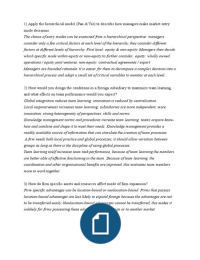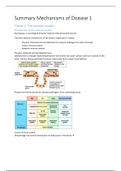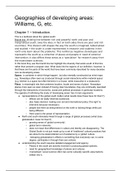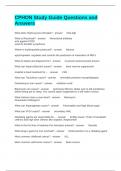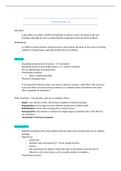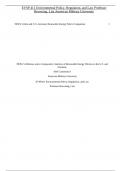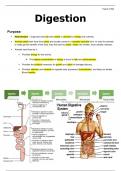1) Apply the hierarchical model (Pan & Tse) to describe how managers make market entry
mode decisions.
The choice of entry modes can be examined from a hierarchical perspective: managers
consider only a few critical factors at each level of the hierarchy, they consider different
factors at different levels of hierarchy. First level: equity & non-equity. Managers then decide
which specific mode within equity or non-equity to further consider, equity: wholly owned
operations / equity joint ventures, non-equity: contractual agreements / export.
Managers are bounded rationale, it is easier for them to decompose a complex decision into a
hierarchical process and adopt a small set of critical variables to monitor at each level.
2) How would you design the conditions in a foreign subsidiary to maximize team learning,
and what effects on team performance would you expect?
Global integration reduces team learning: innovation is reduced by centralization.
Local responsiveness increases team learning: subsidiaries are more independent, more
innovation, strong heterogeneity of perspectives, skills and norms.
Knowledge management norms and procedures increase team learning: teams acquire know-
how and combine and shape it to meet their needs. Knowledge management provides a
readily available source of information that can stimulate the creation of team processes.
A firm needs both local practice and global processes, it should allow variation between
groups as long as there is the discipline of using global processes.
Team learning itself increases team task performance, because of team learning the members
are better able of effective functioning in the team. Because of team learning, the
coordination and other organizational benefits are improved, this motivates team members
more to work together.
3) How do firm specific assets and resources affect mode of firm expansion?
Firm specific advantages can be location-bound or nonlocation-bound. Firms that possess
location-bound advantages are less likely to expand foreign because the advantages are not
to be transferred easily. Nonlocation-bound advantages cannot be transferred, this makes it
unlikely for firms possessing these advantages to go foreign or to another market.
, 4) Explain the effect of inter-firm competition on location choice based on two readings.
Nachum & Wymb: Location choice is affected by heterogeneity among MNEs, they have
different needs for complementary resources in the external environment and varying abilities
to use them effectively. Relationship between product differentiation and location choice.
Barlett & Ghoshal: location determines the locus of control over resources. A firm possesses
transnational capabilities when it is able to manage across national boundaries, retain local
flexibility while achieving global integration.
Fabrizio & Thomas: innovation is shaped by the local technological knowledge environment
and the local demand environment. Competitive advantage is associated with location,
demand conditions determine the national innovative capacity.
5) What determines the design of HR practices and their effectiveness in a multinational
corporation? Give two examples to illustrate your answer.
6) Compare the network theory (Guler & Guillen) of international expansion with the
evolutionary knowledge based theory (Kogut & Zander). Focus on firm competitive
advantage and the role of other firms in the same industry.
7) How accurately does the course literature represent international management research in
terms of (source of) data?
8) According to the S-curve hypothesis, what can you conclude from a medium level of
geographic diversification of an MNC and which predictions can you make for firm
performance?
9) Which strategic choices of an MNC would you analyze to determine whether it is pursuing
a global or a multidomestic strategy? Explain your answer, using examples from the literature.
mode decisions.
The choice of entry modes can be examined from a hierarchical perspective: managers
consider only a few critical factors at each level of the hierarchy, they consider different
factors at different levels of hierarchy. First level: equity & non-equity. Managers then decide
which specific mode within equity or non-equity to further consider, equity: wholly owned
operations / equity joint ventures, non-equity: contractual agreements / export.
Managers are bounded rationale, it is easier for them to decompose a complex decision into a
hierarchical process and adopt a small set of critical variables to monitor at each level.
2) How would you design the conditions in a foreign subsidiary to maximize team learning,
and what effects on team performance would you expect?
Global integration reduces team learning: innovation is reduced by centralization.
Local responsiveness increases team learning: subsidiaries are more independent, more
innovation, strong heterogeneity of perspectives, skills and norms.
Knowledge management norms and procedures increase team learning: teams acquire know-
how and combine and shape it to meet their needs. Knowledge management provides a
readily available source of information that can stimulate the creation of team processes.
A firm needs both local practice and global processes, it should allow variation between
groups as long as there is the discipline of using global processes.
Team learning itself increases team task performance, because of team learning the members
are better able of effective functioning in the team. Because of team learning, the
coordination and other organizational benefits are improved, this motivates team members
more to work together.
3) How do firm specific assets and resources affect mode of firm expansion?
Firm specific advantages can be location-bound or nonlocation-bound. Firms that possess
location-bound advantages are less likely to expand foreign because the advantages are not
to be transferred easily. Nonlocation-bound advantages cannot be transferred, this makes it
unlikely for firms possessing these advantages to go foreign or to another market.
, 4) Explain the effect of inter-firm competition on location choice based on two readings.
Nachum & Wymb: Location choice is affected by heterogeneity among MNEs, they have
different needs for complementary resources in the external environment and varying abilities
to use them effectively. Relationship between product differentiation and location choice.
Barlett & Ghoshal: location determines the locus of control over resources. A firm possesses
transnational capabilities when it is able to manage across national boundaries, retain local
flexibility while achieving global integration.
Fabrizio & Thomas: innovation is shaped by the local technological knowledge environment
and the local demand environment. Competitive advantage is associated with location,
demand conditions determine the national innovative capacity.
5) What determines the design of HR practices and their effectiveness in a multinational
corporation? Give two examples to illustrate your answer.
6) Compare the network theory (Guler & Guillen) of international expansion with the
evolutionary knowledge based theory (Kogut & Zander). Focus on firm competitive
advantage and the role of other firms in the same industry.
7) How accurately does the course literature represent international management research in
terms of (source of) data?
8) According to the S-curve hypothesis, what can you conclude from a medium level of
geographic diversification of an MNC and which predictions can you make for firm
performance?
9) Which strategic choices of an MNC would you analyze to determine whether it is pursuing
a global or a multidomestic strategy? Explain your answer, using examples from the literature.

